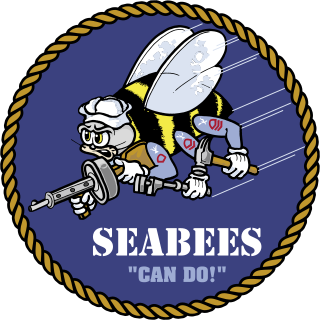
United States Naval Construction Battalions, better known as the Navy Seabees, form the U.S. Naval Construction Forces (NCF). The Seabee nickname is a heterograph of the initial letters "CB" from the words "Construction Battalion". Depending upon context, "Seabee" can refer to all enlisted personnel in the USN's occupational field 13 (OF-13), all personnel in the Naval Construction Force (NCF), or Construction Battalion. Seabees serve both in and outside the NCF. During World War II they were plank-holders of both the Naval Combat Demolition Units and the Underwater Demolition Teams (UDTs). The men in the NCF considered these units to be "Seabee". In addition, Seabees served as elements of Cubs, Lions, Acorns and the United States Marine Corps. They also provided the manpower for the top secret CWS Flame Tank Group. Today the Seabees have many special task assignments starting with Camp David and the Naval Support Unit at the Department of State. Seabees serve under both Commanders of the Naval Surface Forces Atlantic/Pacific fleets as well as on many base Public Works and USN diving commands.

The Civil Engineer Corps (CEC) is a staff corps of the United States Navy. CEC officers are professional engineers and architects, acquisitions specialists, and Seabee Combat Warfare Officers who qualify within Seabee units. They are responsible for executing and managing the planning, design, acquisition, construction, operation, and maintenance of the Navy's shore facilities. The Civil Engineer Corps is under the command of the Chief of Civil Engineers and Commander, Naval Facilities Engineering Systems Command. On 12 August 2022, RADM Dean VanderLey relieved RADM John W. Korka, becoming the 46th commander of NAVFAC and Chief of Civil Engineers.
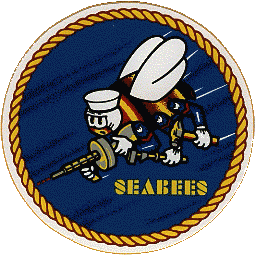
When World War II broke out the United States Naval Construction Battalions (Seabees) did not exist. The logistics of a two theater war were daunting to conceive. Rear Admiral Moreell completely understood the issues. What needed to be done was build staging bases to take the war to the enemy, across both oceans, and create the construction force to do the work. Naval Construction Battalions were first conceived at Bureau of Yards and Docks (BuDocks) in the 1930s. The onset of hostilities clarified to Radm. Moreell the need for developing advance bases to project American power. The solution: tap the vast pool of skilled labor in the U.S. Put it in uniform to build anything, anywhere under any conditions and get the Marine Corps to train it. The first volunteers came skilled. To obtain these tradesmen, military age was waived to age 50. It was later found that several past 60 had managed to get in. Men were given advanced rank/pay based upon experience making the Seabees the highest paid group in the U.S. military. The first 60 battalions had an average age of 37.
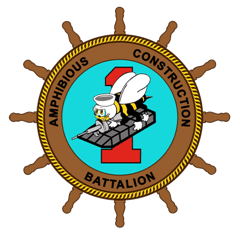
Amphibious Construction Battalion ONE is an amphibious construction battalion in the United States Navy based in Coronado, California, and last in type unit. Amphibious Construction Battalion TWO was its sister unit based in Little Creek, Virginia.

The 22nd Marine Regiment is an inactive United States Marine Corps infantry regiment. The regiment was commissioned in 1942 and was placed under the command of the 1st Provisional Marine Brigade in 1944, and the 6th Marine Division in 1945. It took part in fighting at the battles of Eniwetok, Guam, and Okinawa. The regiment also participated in the occupation of northern China following the war. 22d Marines was decommissioned in March 1946.
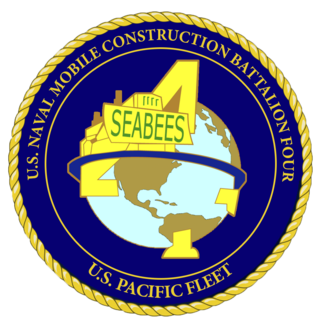
Naval Mobile Construction Battalion 4 is a Navy Seabee battalion homeported at Port Hueneme, California. Nicknamed the "Pioneers", it is the first of the many CBs created after the original three. The battalion's current insignia first appeared on its 1953–55 cruisebook.
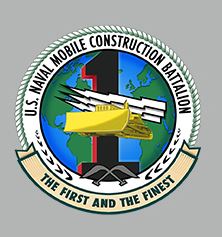
Naval Mobile Construction Battalion 1, is a United States Navy Seabee battalion. NMCB ONE, the original "Pioneers", has a long, proud and distinguished history as the very first Naval Construction Battalion of the service that would become known as the Seabees.

Rear Admiral Katherine Louise Gregory is the first female flag officer in the United States Navy Civil Engineer Corps (CEC). She assumed command of Naval Facilities Engineering Command (NAVFAC) Pacific on July 9, 2010, and took command of all NAVFAC as the highest-ranked civil engineer in the navy in 2012. In November 2015, RADM Gregory was succeeded by RADM Bret J. Muilenburg.
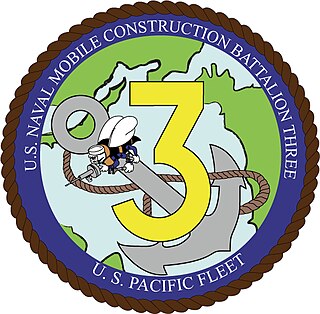
Naval Mobile Construction Battalion THREE is a United States Navy Seabee that was one of the three original Construction Battalions authorized to be formed in 1942. In May 1942 Naval Construction Battalion 3 deployed to the Territory of Hawaii and designated Brigade Headquarters Battalion for the Hawaiian Area NCF. After seeing service in the south Pacific,the battalion was decommissioned mid-1944. In 1950 the battalion was reactivated and today is home-ported at Port Hueneme, California.

Amphibious Construction Battalion TWO was an amphibious construction battalion in the United States Navy based in Little Creek, Virginia. ACB 2 was decommissioned on 31 March 2023.

Naval Mobile Construction Battalion FORTY, nicknamed Fighting FORTY, was a US Navy Seabee Battalion based out of Port Hueneme, California. Its primary mission was wartime contingency construction as well as peacetime construction and disaster relief.

Naval Mobile Construction Battalion 133 is a United States Navy Construction Battalion, otherwise known as a Seabee battalion, homeported at the Naval Construction Battalion Center. The unit was formed during WWII as the 133rd Naval Construction Battalion. It saw action and was decommissioned shortly after the war ended. The unit was reactivated as Mobile Construction Battalion 133 for the Vietnam War and remains an active unit today.

Naval Mobile Construction Battalion SEVEN (NMCB 7) was a Navy Seabee battalion last homeported at Naval Construction Battalion Center, Gulfport Mississippi. Nicknamed the "Magnificent Seven", it is one of the first ten Naval Construction Battalions formed by the U.S. Navy in 1942.

Naval Construction Battalion Center is a 1,100-acre (450 ha) U.S. Navy industrial complex located in Gulfport, Mississippi. It serves as home base for the Atlantic Fleet Seabees, which are the Navy's construction battalions.

Construction Battalion Maintenance Unit THREE ZERO TWO (CBMU-302) of the U.S. Navy was commissioned on 31 March 1967. Along with a sister unit, CBMU-301, was also commissioned. They were the first CBMUs commissioned since the two that came and went with the Korean War. The official commissioning ceremony of CBMU-301 and CBMU-302 was held at the U.S. Naval Construction Battalion Center, Port Hueneme, CA on 7 April 1967. LT Mel Harper was the first Commanding Officer.

Naval Mobile Construction Battalion (NMCB) 15 is a United States Navy Reserve Seabee battalion. NMCB 15 is an expeditionary element of U.S. Naval Forces that support various units worldwide through national force readiness, humanitarian assistance, and building and maintaining infrastructure.

Naval Mobile Construction Battalion TWO SIX was a United States Navy Seabee battalion commissioned in 1942 for support to Naval Operations in the Pacific Theater in World War II and later a Reserve Naval Construction Battalion based in various locations in the Midwest from 1962 until 2014.

Naval Mobile Construction Battalion 25 or NMCB 25 is a Navy Reserve Seabee unit that is headquartered at Port Hueneme, CA. Its World War II predecessor was one of three CBs transferred to the Marine Corps in the late summer of 1942 as combat engineers. Those three battalions were attached to composite Marine Engineer Regiments as the third battalion of their respective regiment. All of them remained with the Marine Corps for the next two years before they were released and returned to the Navy. At the end of World War II the battalion was decommissioned. In 1961, it was recommissioned in the Naval Construction Force Reserve where it remains today.

Naval Mobile Construction Battalion 11 is a United States Navy Construction Battalion, otherwise known as a Seabee Battalion, presently home-ported at the Naval Construction Battalion Center. The unit was formed during World War II as the 11th Naval Construction Battalion at Camp Allen on 28 June 1942. On 1 July, she moved to the new Seabee base Camp Bradford. Seabee battalions were numbered sequentially in the order they were stood up. The battalion lost one man during the war to a construction accident. The 11th CB was inactivated on 1 December 1945, at Subic Bay, Philippines.

Underwater Construction Teams (UCT) are the United States Navy Seabees' underwater construction units numbered 1 and 2 that were created in 1974. A team is composed of divers qualified in both underwater construction and underwater demolition. Possible tasks can be: battle damage repairs, structural inspections and assessments, demolition of waterline facilities or submerged obstructions, installation of submerged surveillance systems, or harbor and channel clearance. As needed, teams may test and or evaluate new or existing aquatic systems or equipment. Extending construction, whether vertical or horizontal, beyond the shoreline and waterline is their specialty. Reflecting Seabee tradition, teams are expected to execute underwater construction anywhere, anytime, under any conditions.


































